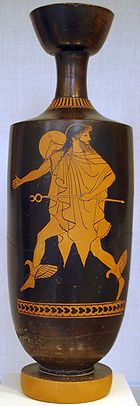
Chlamys
Encyclopedia

- For the scallop genus, see Chlamys (genus). The beetle genus described as Chlamys is now NeochlamisusNeochlamisusLeaf beetles of the genus Neochlamisus are sometimes known as the warty leaf beetles. They are members of the case-bearing leaf beetle group, the Camptosomata. Measuring 3-4 millimeters in length as adults, they are cryptic, superficially resembling caterpillar frass...
.
The chlamys (Ancient Greek
Greek language
Greek is an independent branch of the Indo-European family of languages. Native to the southern Balkans, it has the longest documented history of any Indo-European language, spanning 34 centuries of written records. Its writing system has been the Greek alphabet for the majority of its history;...
: χλαμύς, gen.: χλαμύδος; also known as the ephaptis [ἐφαπτίς]) was an ancient Greek
Ancient Greece
Ancient Greece is a civilization belonging to a period of Greek history that lasted from the Archaic period of the 8th to 6th centuries BC to the end of antiquity. Immediately following this period was the beginning of the Early Middle Ages and the Byzantine era. Included in Ancient Greece is the...
piece of clothing
Clothing
Clothing refers to any covering for the human body that is worn. The wearing of clothing is exclusively a human characteristic and is a feature of nearly all human societies...
, a type of cloak
Cloak
A cloak is a type of loose garment that is worn over indoor clothing and serves the same purpose as an overcoat; it protects the wearer from the cold, rain or wind for example, or it may form part of a fashionable outfit or uniform. Cloaks are as old as human history; there has nearly always been...
.
The chlamys was made from a seamless rectangle of woolen
Wool
Wool is the textile fiber obtained from sheep and certain other animals, including cashmere from goats, mohair from goats, qiviut from muskoxen, vicuña, alpaca, camel from animals in the camel family, and angora from rabbits....
material about the size of a blanket, usually bordered. It was normally pinned with a fibula at the right shoulder. Originally it was wrapped around the waist like a loincloth, but by the end of the 5th century BC it was worn over the elbows. It could be worn over another item of clothing, but was often the sole item of clothing for young soldiers and messengers, at least in Greek art. As such, the chlamys is the characteristic garment of Hermes
Hermes
Hermes is the great messenger of the gods in Greek mythology and a guide to the Underworld. Hermes was born on Mount Kyllini in Arcadia. An Olympian god, he is also the patron of boundaries and of the travelers who cross them, of shepherds and cowherds, of the cunning of thieves, of orators and...
(Roman Mercury
Mercury (mythology)
Mercury was a messenger who wore winged sandals, and a god of trade, the son of Maia Maiestas and Jupiter in Roman mythology. His name is related to the Latin word merx , mercari , and merces...
), the messenger god usually depicted as a young man.
The chlamys was typical Greek military attire
Military history of ancient Greece
The military history of ancient Greece is the history of the wars and battles of the Greek people in Greece, the Balkans and the Greek colonies in the Mediterranean Sea and the Black Sea prior to 400 AD.-Prehistoric and Ancient period:*Trojan War...
from the 5th to the 3rd century BC. As worn by soldiers, it could be wrapped around the arm and used as a light shield in combat.
The chlamys continued into the Byzantine period
Byzantine dress
Byzantine dress changed considerably over the thousand years of the Empire, but was essentially conservative. The Byzantines liked colour and pattern, and made and exported very richly patterned cloth, especially Byzantine silk, woven and embroidered for the upper classes, and resist-dyed and...
, when it was often much larger and worn sideways. It was held on with a clasp at the shoulder, and nearly reached the ground at front and back.
Sources
- Sekunda, Nicholas (2000). Greek Hoplite 480–323 BC. Osprey Publishing. ISBN 1855328674
- Ridgway, S. Brunilde (1990). Hellenistic Sculpture: The Styles of ca. 331–200 B.C. University of Wisconsin Press. ISBN 0299167100

